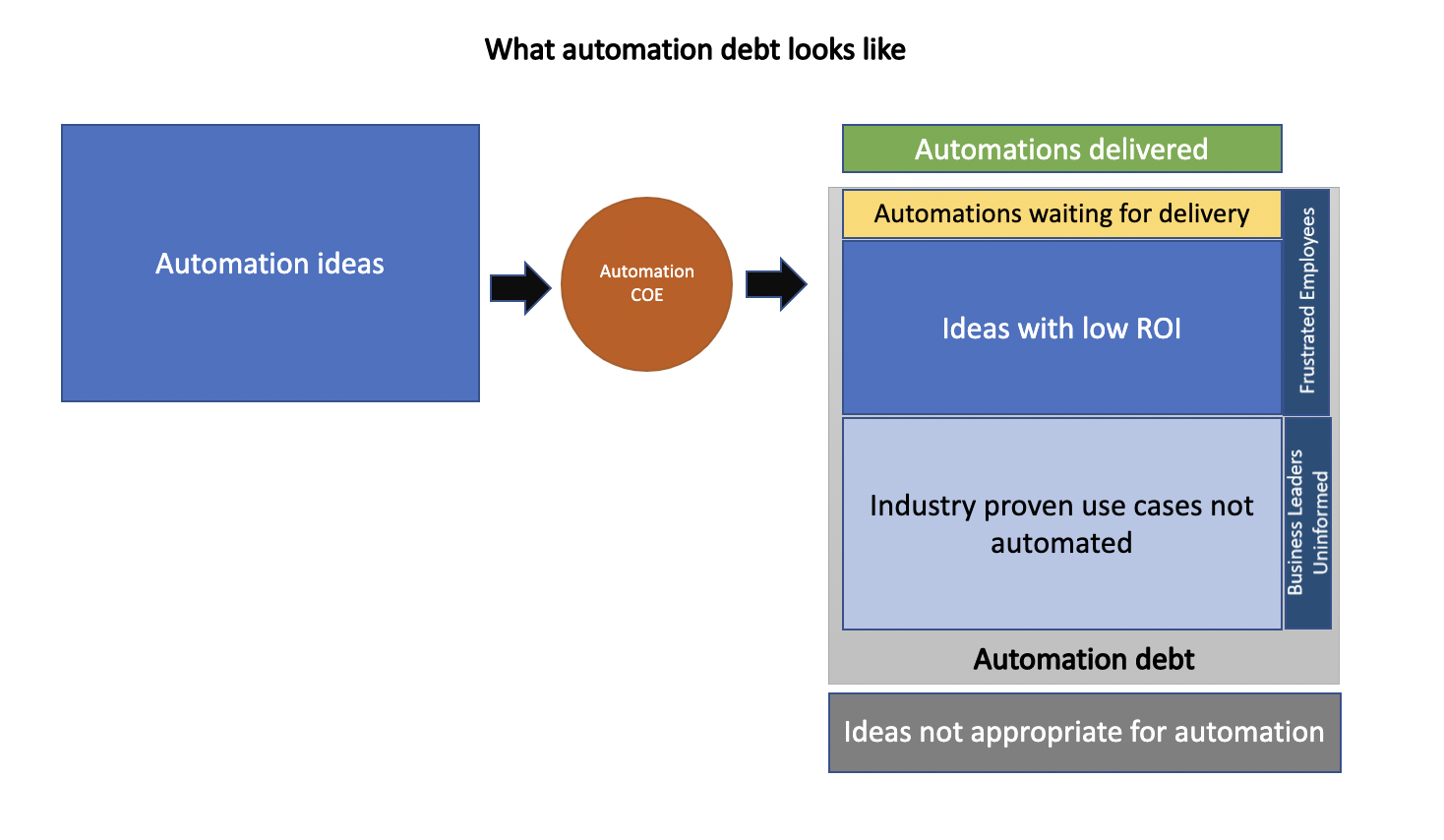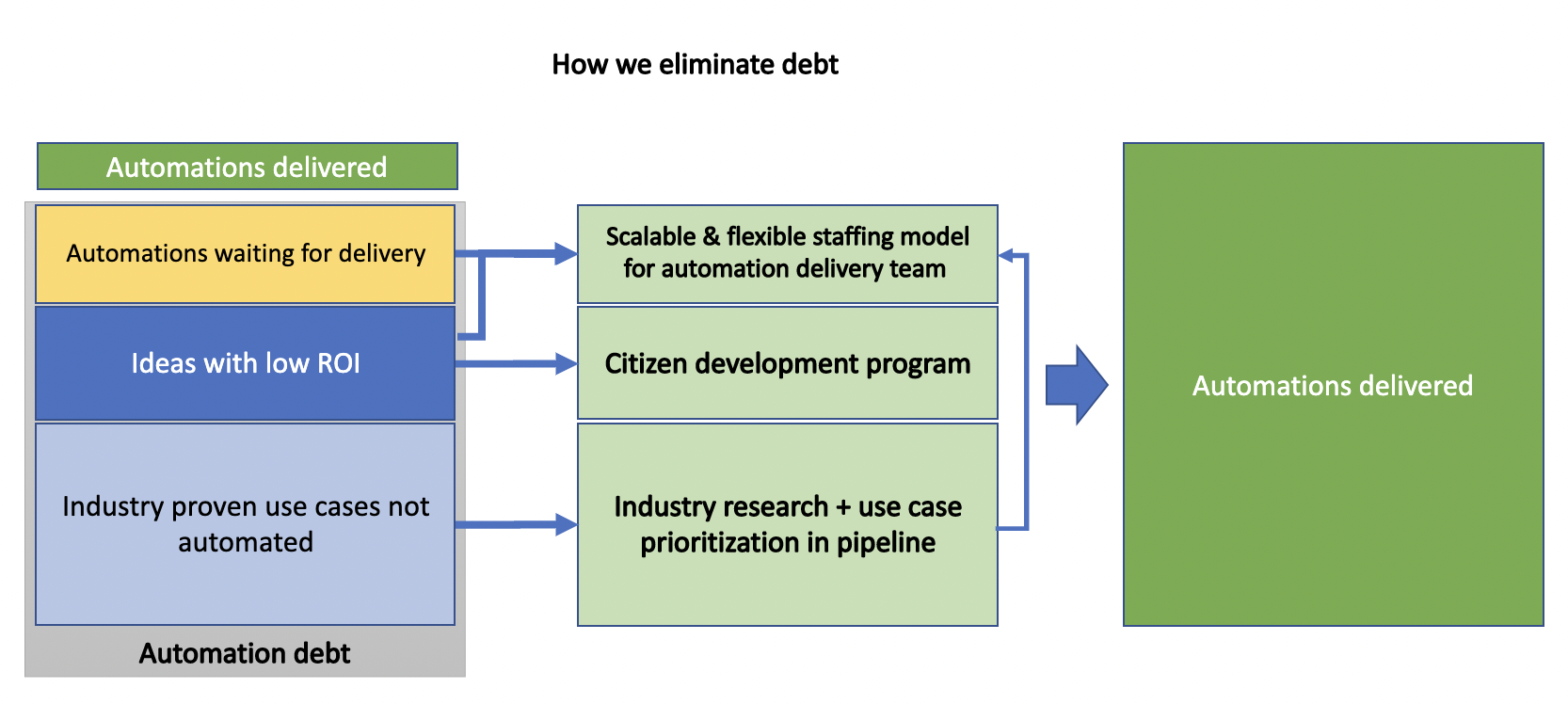Your Guide to Eliminating Automation Debt
Share at:

What’s automation debt?
Automation is as much an idea of what life and work can be as it is about tangible solutions that deliver real value for the business. A successful automation program requires both that:
Any employee in your organization feels empowered and able to find work that can be automated
There is an operating model in place to ensure that solution is delivered
When automation opportunities are identified and not delivered, they become debt—automation debt.
With most of my career spent in IT, technology debt is nothing new to me. I’ve seen dozens of solution ideas, both big and small, being relegated to an endless backlog that fueled a multi-year roadmap of changes and enhancements. Workarounds, quick fixes, manual efforts, and delayed delivery of capabilities were the typical ramifications.
With automation debt, I am not only talking about the parts of the processes you did not automate, but also the entire processes that have not even been assessed or prioritized for automation. Especially those common processes that most of your peer organizations in the industry have already started to automate, scale, and strategically reinforce to have a competitive edge in the market.

Ramifications of having automation debt
It’s ingrained in our minds: debt is bad.
But why is debt bad?
Debt puts us at a disadvantage—a place where we ‘work’ for the past and not the future. A place where we can't focus our full energy on growth, innovation, and seizing opportunities. For your organization, automation debt has the same impact and could limit your organization from reaching its full potential.
The first and most prevalent cost of not automating processes that can be automated is the opportunity cost (I discuss this in one of my prior blogs that I wrote earlier this year). Simply put, by waiting to automate business-critical processes, you are placing your organization at a competitive disadvantage. The organizations that embrace automation across the enterprise will be able to scale more quickly, more efficiently, and with higher quality.
Related read: The Fully Automated Enterprise Is Here (and This Is What It Looks Like)
Company culture and employee engagement are paramount to a successful organization, but these are also at risk if an automation program cannot scale quickly enough.
If you knew that any idea you were going to submit would just sit in a backlog indefinitely, how motivated would you be to submit a new automation idea?
If the associates across your business units do not feel like their automation ideas will get solutioned, they will stop submitting ideas and disengage. Automation programs, more than any other technology program I have witnessed, are totally reliant on business engagement. After all, we are automating tasks that employees do today.
Employees have great automation ideas but will become frustrated if the automation program can't help them get those solutions delivered quickly or in some cases not at all because the “savings” are too small compared to other opportunities in the pipeline. This is compounded by employees hearing from their industry peers about what their organizations are doing to enable them with automation.
Your automation backlog is built by the business; it is not built by the automation development team. One of the key value propositions of robotic process automation (RPA) and all other parts of the UiPath Platform is the ability to create automation solutions quickly and help business users become more efficient, effective, and satisfied in their roles.
You must find a way to automate a majority of the opportunities that the business brings forward if you want to fully deliver the promise of automation to your business constituents.
Becoming debt free
The relationship between your automation program and your business constituents will be one of the key determinants in your success of achieving a fully automated enterprise™. To become debt free will require that you act quickly and deliberately, with proven best practices available. It will come as no surprise that you must have an appropriate investment in the size of the delivery team to keep building the larger processes in your automation pipeline quickly.
When I was a customer, I did not want anything to sit in my pipeline for more than six months. At times, I would even get processes delivered within the quarter because they were time-sensitive opportunities. Having a flexible resourcing model with a partner was key to automating processes quickly. I was able to onboard additional skilled RPA developers/testers quickly when I had a spike in demand in my pipeline.
Every automation program leader should have a plan defined of how they will scale their delivery capacity to address a significant increase in demand.
You must tackle the industry-proven, high-value processes such as invoice processing, accounts payable, employee onboarding, new account setup, etc. These are the processes that each of your industry peers have likely already automated. This is part of the debt you need to eliminate to catch up to your competition and to do so, you must know where to look. I’d recommend reaching out to a certified UiPath consulting partner or your UiPath account executive to get more insights on this.
Citizen development is a win, win, win
Many of your employees across all the business units know where the automation opportunities are. They feel monotony and inefficiency in their daily work, and they want to learn new skills and technologies. Citizen development allows you to find solid automation opportunities, relieve pain points, and upskill business users by allowing them to build their own robots.
Related read: Understanding Citizen Developers: Your Secret Weapon in Scaling Automation
We must remember that many of the associates performing processes today have a limited view of that process. They know the specific steps they perform. This means that sometimes the automation ideas are limited to that span and can be small compared to some of the end-to-end process ideas submitted.
The smaller automation ideas will not rank high on the backlog for the automation team to deliver, which is why these are the type of ideas that are a perfect opportunity for citizen development.
I’ll be providing additional guidance on best practices to establish and run a successful citizen development program in my next blog, so stay tuned.

In summary, getting free of automation debt is not that complicated, but it will take bold steps and sponsorship from your executive team to make it happen.
Now it’s time for you to go payoff that debt quickly. Go right-size and ensure scalability of your delivery team, get the industry-proven processes into your backlog, and start the pilot and rollout of your citizen development program. Everyone is happier when debt-free.
Join the conversation and share the ways your organization is eliminating automation debt.

VP - Strategic Engagements & Operations, UiPath
Get articles from automation experts in your inbox
SubscribeGet articles from automation experts in your inbox
Sign up today and we'll email you the newest articles every week.
Thank you for subscribing!
Thank you for subscribing! Each week, we'll send the best automation blog posts straight to your inbox.



